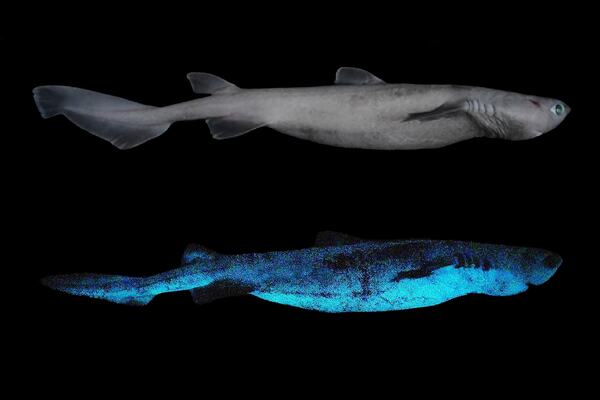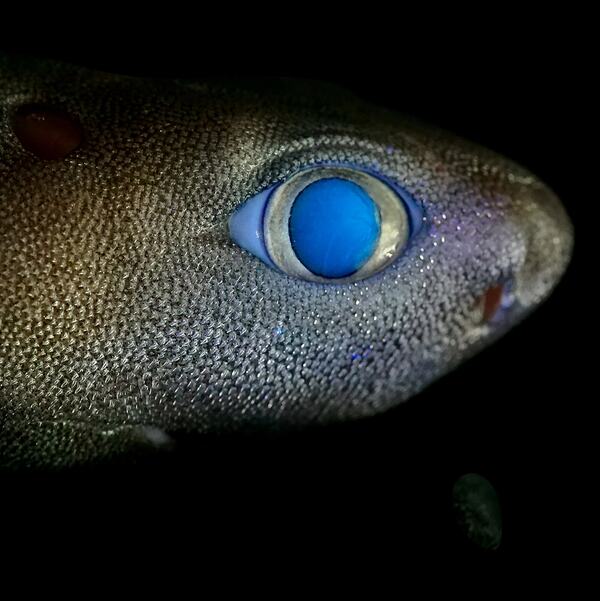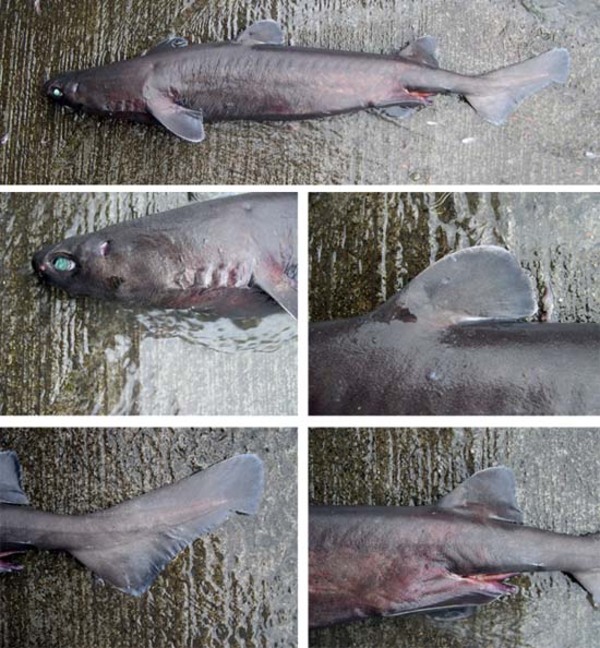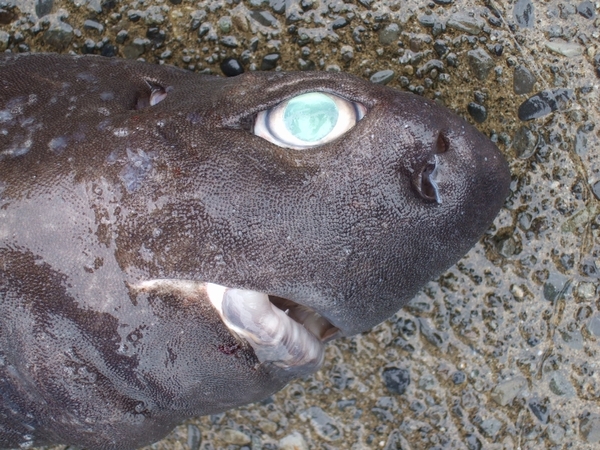The deep oceans of our planet remain one of the last frontiers of exploration, and within the dark depths, scientists continue to discover remarkable creatures that are unlike anything found on land. Among these enigmatic beings is the kitefin shark, which has recently been recognized as the world’s largest known luminous vertebrate.

The kitefin shark (scientific name: Dalatias licha) is an awe-inspiring species not only due to its size but also because it possesses an extraordinary ability: it can emit light. This biological feature, known as bioluminescence, allows the kitefin shark to produce its own glow, which is a rare and fascinating trait for a vertebrate. The light is generated by special cells in its body called photophores, which contain proteins that emit light when triggered.
While many species of deep-sea fish, jellyfish, and other marine creatures use bioluminescence for various purposes such as attracting prey, camouflaging from predators, or communicating with others, the kitefin shark's glowing ability remains an amazing adaptation for survival in the darkness of the deep ocean.

The kitefin shark holds the title of the largest known luminous vertebrate, growing up to a length of about 6.6 feet (2 meters). This makes it larger than many of the other bioluminescent animals found in the ocean, including fish and invertebrates. Despite its size, the kitefin shark is relatively elusive and spends most of its time in the mesopelagic zone — the part of the ocean that lies between 656 and 3,280 feet (200 and 1,000 meters) deep. This zone is often referred to as the twilight zone because it is too deep for sunlight to penetrate, creating a dark and mysterious environment.
In this deep-sea habitat, the kitefin shark likely uses its bioluminescence to attract smaller fish and other prey. It is believed to feed on a diet of smaller fish and squid, but it may also use its glowing ability as a defense mechanism, confusing potential predators or rival hunters in the pitch-black depths.
The discovery that the kitefin shark is the largest bioluminescent vertebrate adds another layer to our understanding of deep-sea creatures. While many bioluminescent species are known to inhabit the ocean’s depths, the kitefin shark’s luminous capability is particularly significant due to its size and the fact that it is a vertebrate — an animal with a backbone.
Until this discovery, the largest bioluminescent vertebrates were thought to be species like the lanternfish, which are much smaller in comparison. This revelation not only highlights the adaptability of marine life but also underscores how much remains to be explored and discovered in the mysterious, dark regions of the ocean.
Bioluminescence occurs when certain chemicals inside an organism react with oxygen, producing light. This light can be blue, green, or even red, depending on the species and its environment. For sharks like the kitefin, bioluminescence might serve a variety of functions, from attracting prey to signaling other sharks in the dark waters. The glow is often emitted in patterns that can be controlled, allowing the shark to either emit a constant light or flash it on and off.

The kitefin shark's remarkable ability to glow is just one of the many adaptations that allow animals to survive in the extreme conditions of the deep ocean. The ocean's depths are vast, dark, and largely unexplored, but as we learn more about these mysterious environments, we discover that life has found countless ways to thrive in even the harshest conditions.
The kitefin shark’s bioluminescence serves as a reminder of how much we still have to learn about the deep sea and the incredible creatures that inhabit it. As scientists continue to study these creatures, we may uncover even more secrets about life in the ocean's twilight zone — secrets that could one day change our understanding of biology, evolution, and survival in the most extreme environments.
The kitefin shark’s bioluminescence is a stunning example of nature’s ingenuity. As the largest known luminous vertebrate, this shark proves that even the darkest, most unexplored parts of our planet are home to fascinating, extraordinary creatures. From its glowing body to its deep-sea lifestyle, the kitefin shark is yet another reminder of the wonders of our natural world that remain waiting to be discovered in the deep, dark ocean.
Bioluminescence is a remarkable natural phenomenon that allows certain organisms to produce light. While many think of glowing creatures like fireflies or jellyfish when they hear the term bioluminescence, some vertebrates, including fish and amphibians, also possess this intriguing ability. These bioluminescent vertebrates thrive in the depths of the ocean, where sunlight doesn’t reach, using their glowing abilities for various purposes like attracting prey, communication, and camouflage. In this article, we’ll explore some of the most notable bioluminescent vertebrates other than the kitefin shark.
Lanternfish are among the most well-known bioluminescent vertebrates. These small, deep-sea fish have light-producing organs called photophores on their bodies. They use bioluminescence primarily for attracting prey and communication. Lanternfish are a key part of the ocean’s twilight zone (the mesopelagic zone), where they are found at depths ranging from 200 to 1,000 meters. Their glowing bodies help them blend in with the faint light from above, making them harder to spot by predators.
The cookiecutter shark, a small deep-sea shark, is another bioluminescent vertebrate. These sharks have light-producing organs along their bellies and on their underside, which they likely use for camouflage in the dark waters of the deep ocean. By matching the faint light coming from the surface, they can avoid predators and maintain a low profile while hunting.
The cookiecutter shark is also known for its unusual feeding behavior, in which it takes circular "cookie-like" bites out of larger animals, including whales, dolphins, and even other sharks. The bioluminescence likely aids in their ability to remain undetected while feeding at night.
Glass frogs, which live in Central and South America, are another fascinating example of bioluminescent vertebrates. While they aren’t as widely known for their glowing ability as deep-sea fish, some species of glass frogs have been observed to exhibit bioluminescent organs on their undersides, which might play a role in communication or mating displays. The frogs' ability to emit light is typically more subtle and is believed to be more of a social or reproductive adaptation.
The barreleye fish is a strange deep-sea fish with a transparent head and large, barrel-shaped eyes. It is known for its ability to glow faintly. While the exact purpose of its bioluminescence is still debated, researchers believe that the glow may help it attract prey or communicate with others. These fish live in depths of about 600 meters and lower, where sunlight is almost nonexistent, so bioluminescence serves as a critical survival tool.
The hatchetfish, a deep-sea fish named for its thin, flat body, is another bioluminescent vertebrate. It has photophores along its belly, which help it produce light to blend in with the faint light from the surface, a tactic known as counter-illumination. By emitting light from its underside, the hatchetfish can reduce its shadow and avoid detection by predators from below.
These fish are found in the mesopelagic zone of the ocean, often at depths of around 200 to 1,000 meters, and they rely heavily on their bioluminescence to avoid predators and find food in the dark depths.
The bearded sea devil, or Johnson’s anglerfish, is a bioluminescent predator that uses a glowing lure to attract prey. This fish has a luminous appendage on its head, which it uses to dangle and draw unsuspecting prey closer to its wide, sharp mouth. This bioluminescent lure is crucial for hunting in the deep, dark waters of the ocean where light is scarce. The bearded sea devil is an example of how bioluminescence can be used not only for defense or camouflage but also as an active hunting tool.
The Pacific blackdragon is another deep-sea fish with an ability to glow. This species is one of the few bioluminescent vertebrates that use their glow in a more aggressive way to help hunt. The blackdragon has photophores along its body, which it uses to confuse prey, attract mates, or evade predators. It is found in deep waters between 200 and 1,000 meters, where it hunts small fish and squid.
The pinecone fish, a deep-sea fish found around the Pacific Ocean, has a series of photophores along its body. These glowing spots are believed to be used for attracting prey or communicating with other fish. Despite its name, the pinecone fish’s bioluminescence is not as bright as some other deep-sea species, but it is still a fascinating example of bioluminescence among vertebrates.
The discovery of bioluminescent vertebrates like the kitefin shark has opened our eyes to the wonders of the deep ocean. From small lanternfish to predatory bearded sea devils, these glowing creatures are examples of how life adapts to extreme environments. Bioluminescence offers a range of benefits for survival in the dark ocean depths, from attracting prey and communication to avoiding predators and mating. As we continue to explore the ocean, it's clear that the glowing world of bioluminescence holds many more secrets and wonders waiting to be uncovered.

Bioluminescence is the production and emission of light by living organisms. While this glowing phenomenon may seem like something straight out of a science fiction story, it is a natural trait found in many species, particularly in deep-sea creatures, fungi, and certain insects. But why do some animals glow in the dark? In this article, we'll explore the science behind bioluminescence and why animals, especially in dark environments like the ocean's depths, have developed this fascinating ability.
Bioluminescence occurs through a chemical reaction within the organism’s body. This reaction involves two key components:
Luciferin: A light-emitting molecule that reacts with oxygen.
Luciferase: An enzyme that catalyzes the reaction.
When luciferin reacts with oxygen in the presence of luciferase, it produces light. This process is highly efficient, meaning nearly all the energy is converted into light, with little to no heat produced (this is called "cold light"). The color of the light emitted varies depending on the species and the type of luciferin involved, ranging from blue and green to red.
Bioluminescence serves different purposes depending on the species, and these purposes can often be linked to survival. The ability to glow in the dark provides distinct advantages in the wild, particularly for animals living in environments where light is scarce, like deep oceans, caves, or dense forests. Here are some of the main reasons why animals glow:
One of the most common reasons for bioluminescence is camouflage. Many animals, particularly those that live in deep-sea environments, use their light to blend into the faint light that filters down from the surface. This helps them to avoid being seen by predators or prey.
Counterillumination: Some deep-sea creatures, like lanternfish and hatchetfish, use bioluminescence to match the faint light from above. This technique, known as counterillumination, helps them avoid predators below by making their undersides glow, so they blend in with the surrounding light. It essentially "hides" them from predators that might be looking up from the dark depths of the ocean.
Many predators use bioluminescence to attract prey. This is especially common in the deep sea, where prey might not be able to detect an approaching predator in the darkness.
Anglerfish: Perhaps the most famous example is the anglerfish, which has a glowing lure that hangs in front of its mouth. The light attracts smaller fish and invertebrates, luring them closer so the anglerfish can catch them. The glowing lure is a perfect example of attraction-based bioluminescence.
Lanternfish and Cookiecutter Shark: Some fish, like lanternfish, use their glowing bodies to lure smaller prey towards them, taking advantage of the prey's curiosity.
In some species, bioluminescence is used as a form of communication. This is especially true for species that live in large groups or schools where cooperation is key.
Fireflies: One of the most familiar examples of bioluminescence in insects is the firefly. Male fireflies emit light patterns to attract females, with each species having its own unique flashing rhythm. This helps fireflies find mates in a dark environment.
Fish and Squid: In the deep ocean, certain species of fish and squid use bioluminescent signals to communicate with each other, often during mating or social interactions.
Some animals use bioluminescence as a defensive mechanism. Glowing can confuse or scare off predators, giving the animal a chance to escape.
Jellyfish: Some species of jellyfish, such as the comb jelly, emit a glowing light when disturbed. This could be a form of startle defense, confusing potential predators or deterring them from attacking.
Squids and Cuttlefish: Some squid species can eject a cloud of bioluminescent fluid to distract predators, giving them a chance to flee. This defense mechanism works much like an ink cloud but with the added advantage of glowing in the dark.
In some cases, bioluminescence is linked to reproduction. Animals may glow to signal their availability to mates or to attract mates of the same species.
Anglerfish (again): Female anglerfish are much larger than males and may use their bioluminescence to signal their presence or readiness to mate. Male anglerfish are much smaller and rely on the glow to locate females.
Bioluminescent animals are most commonly found in the deep sea, where there is no natural light. These environments include the mesopelagic zone (200–1,000 meters deep) and the bathypelagic zone (1,000–4,000 meters deep), where creatures are adapted to survive in total darkness. However, bioluminescence is not limited to the ocean:
Terrestrial Bioluminescence: While most bioluminescent organisms are aquatic, there are a few exceptions on land, such as fireflies, certain fungi, and glowing fungi like the foxfire or fairy fire.
Caves: In dark, isolated cave systems, certain species of fish and amphibians also use bioluminescence as part of their survival strategy.
The evolution of bioluminescence likely occurred as a way for organisms to adapt to their environments. Since light is scarce in certain habitats, especially in deep-sea environments, organisms that could create their own light had an advantage in terms of survival. Whether for attracting prey, avoiding predators, or communicating, bioluminescence provided a solution to challenges posed by darkness.
Bioluminescence is a fascinating adaptation found in many animals, allowing them to survive and thrive in environments where sunlight does not penetrate. The reasons for glowing in the dark vary, but bioluminescence is generally used for camouflage, communication, prey attraction, defense, and reproduction. From the deep ocean to dark caves, these glowing creatures continue to inspire wonder, and there’s still so much to discover about how and why bioluminescence has evolved across so many species. It’s a testament to the incredible diversity of life on Earth and the remarkable ways in which creatures have adapted to their surroundings.
animal tags: Kitefin-Shark
We created this article in conjunction with AI technology, then made sure it was fact-checked and edited by a Animals Top editor.